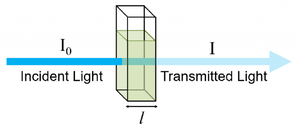Alcohol Concentration Measurement: Difference between revisions
From PC5271 wiki
Jump to navigationJump to search
No edit summary |
No edit summary |
||
| Line 1: | Line 1: | ||
= Experiment to Measure Alcohol Concentration Using Oband Light Source and a Photodetector = | = Experiment to Measure Alcohol Concentration Using Oband Light Source and a Photodetector = | ||
== Team Member == | == Team Member == | ||
Lim Gin Joe | Lim Gin Joe,Sun Weijia, Yan Chengrui, Zhu Junyi | ||
== Overview == | == Overview == | ||
Revision as of 10:46, 1 April 2025
Experiment to Measure Alcohol Concentration Using Oband Light Source and a Photodetector
Team Member
Lim Gin Joe,Sun Weijia, Yan Chengrui, Zhu Junyi
Overview
This experiment aims to measure the concentration of alcohol in a solution using a light source (Oband) and a photodetector. The basic principle behind this setup is that the absorption of light by alcohol varies with concentration, and by measuring the intensity of light transmitted through the solution, we can determine the alcohol concentration.

Objective
To determine the alcohol concentration in a sample solution by analyzing the absorption of light at a specific wavelength using an Oband light source and a photodetector.
Equipment Required
- Oband Light Source: A broadband light source capable of emitting light across a spectrum of wavelengths.
- Photodetector: A device to measure the intensity of light that has passed through the sample solution.
- Alcohol Samples: Different alcohol solutions with known concentrations (e.g., ethanol, isopropanol).
- Cuvette: A transparent container to hold the alcohol solution for light transmission.
- Spectrometer: For recording and analyzing the intensity of transmitted light.
- Power Supply: To power the Oband light source.
Methodology
1. Setup the Apparatus
- Position the Oband Light Source: Place the Oband light source so that the emitted light can be directed towards the alcohol sample in the cuvette.
- Align the Photodetector: Position the photodetector on the opposite side of the cuvette to measure the intensity of light that passes through the alcohol solution.
- Cuvette Setup: Fill the cuvette with the alcohol sample. Ensure that the path of light through the cuvette is clear and that the cuvette is free from air bubbles.
- Ensure Proper Calibration: Before measuring the alcohol samples, calibrate the setup by using a solution of known concentration or distilled water to establish a baseline (zero absorption).
2. Measure Absorbance
- Test Different Concentrations: Prepare alcohol samples of known concentrations. This will allow you to measure the light intensity passing through different levels of alcohol and correlate the intensity with the concentration.
- Record Light Intensity: For each sample, measure the light intensity that reaches the photodetector. Record the values using the spectrometer. Ensure to measure the intensity multiple times for each concentration to ensure accuracy.
3. Analyze the Results
- Calculate Absorbance: Use the formula:
where is absorbance, is the intensity of light from the Oband source, and is the intensity of light received by the photodetector after passing through the alcohol solution.
- Plot the Absorbance vs Concentration: Create a graph to visualize the relationship between absorbance and alcohol concentration. The graph should show a linear or near-linear correlation.
- Determine the Alcohol Concentration: Using the absorption curve and the known concentration values, estimate the alcohol concentration of an unknown sample by comparing its absorbance value.
Data Analysis
1. Beer-Lambert Law: The relationship between absorbance and concentration is governed by the Beer-Lambert Law, which states:
Where: * is the absorbance, * is the molar absorptivity (a constant for the alcohol), * is the concentration of the alcohol, * is the path length of light through the sample.
References
- Beer-Lambert Law for Spectrophotometry
- Applications of Optical Sensing for Chemical Analysis
- Practical Guide to Spectrometer Calibration